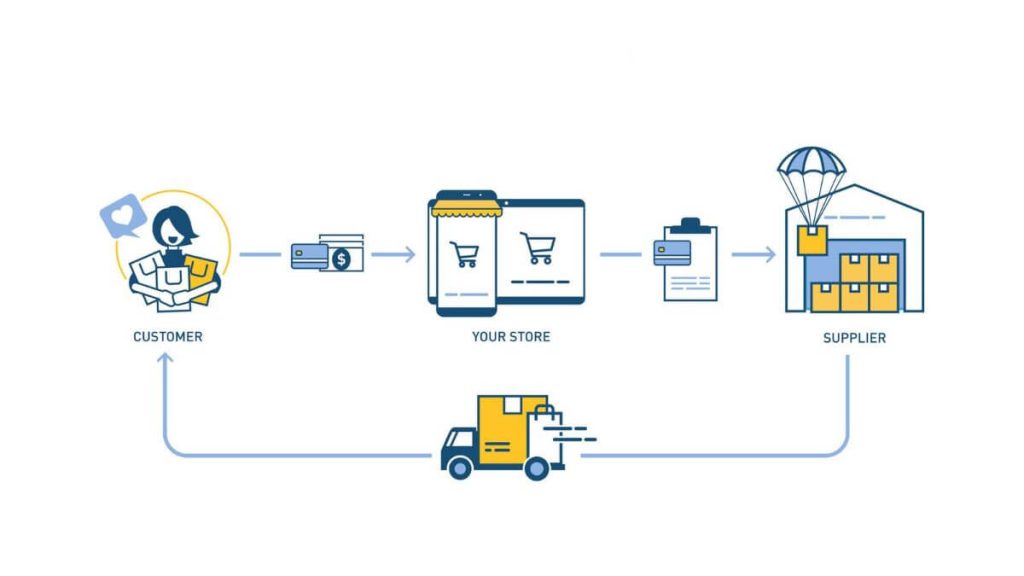In traditional trading, stores import products from one or more suppliers and sell them on their websites. When a customer places an order, the store ships the item directly from their inventory to the purchaser. As products are about to run out of stock, stores must import more items from their providers to maintain inventory levels.
What is Dropshipping?
Dropshipping allows a store to display and advertise products on its website without keeping them in stock. The store can get the products from suppliers who will handle the importing process.
When there is a new order on the site, the store owner/ admin will manually forward that order including the purchased item and buyer information to the drop shippers (this process can be automatic also). Then, the drop shippers will be responsible for the remaining steps of order fulfillment (packaging and delivering)
There are many advantages in operating this kind of business such as ease of setup, low cost to start an online business, minimizing overhead costs, location independence, various types of products to sell, and high scalability. Therefore, it’s immensely suitable for startups or businesses that are looking for product variation and flexibility.
On the other hand, dropshipping has its drawbacks such as low profit margins, lack of control over product quality and availability, unpredictable shipping costs, and intense competition.
Selecting the right dropshipping e-commerce Platform?
Now there are a lot of eCommerce platforms for dropshipping business owners to choose from. For example Magento, Prestashop, Shopify, BigCommerce, OpenCart, 3dCart, OSCommerce, WooCommerce, WP eCommerce, Drupal, Spree, and so on.
To make the process of drop shipping eCommerce platform selection much easier, we would like to suggest you compare these platforms based on 5 fundamental criteria:
- Setup time and cost
- E-commerce Features
- Ease of Use
- Scalability
- Support
Top e-commerce platforms for dropshipping businesses?
Magento
Magento has emerged as a dominant eCommerce platform for drop shipping. It offers two versions – Magento 1 and Magento 2 (the latter being highly recommended) – and two editions – Magento Open Source (which is free) and Magento Commerce (which is premium). This provides the owner with the flexibility to choose the most suitable option.
- Setup time and cost
- E-commerce features
- Ease of use
- Scalability
WooCommerce
Another popular eCommerce platform for dropshipping is WooCommerce. If what you expect for your store is just very basic functionality and ease of use, WooCommerce might be an ideal solution.
When comparing Magento and WooCommerce, it is important to note that WooCommerce has fewer advanced eCommerce features. However, it is more user-friendly for beginners. On the other hand, developers may find this platform difficult to customize as most of its functionalities must be acquired through third-party plugins.
- Setup time and cost
- E-commerce features
- Ease of use
- Scalability
- Support
Shopify
The third platform on the list of best eCommerce solutions for dropshipping is Shopify. So far, Shopify has enabled almost more than 4.4 million e-commerce stores worldwide, including those involved in drop shipping.
- Setup time and cost
- E-commerce Features
- Ease of Use
- Scalability
- Support
Also read | How to start a successful E-Commerce Business in 2025 – A Step-by-Step Strategy
All of the eCommerce platforms for dropshipping that we have mentioned are excellent, but we are more inclined towards Magento and WooCommerce. These two platforms are highly popular due to their stability, flexibility, and scalability, and are widely used for creating eCommerce websites around the world. If you need further assistance or quotes for developing your website using any of these eCommerce platforms for dropshipping, feel free to contact Infovistar. We are a leading eCommerce development company and can provide the necessary guidance and support.
For Inquiries
- Contact: +91 91588 76092
- Email: sales@infovistar.in

